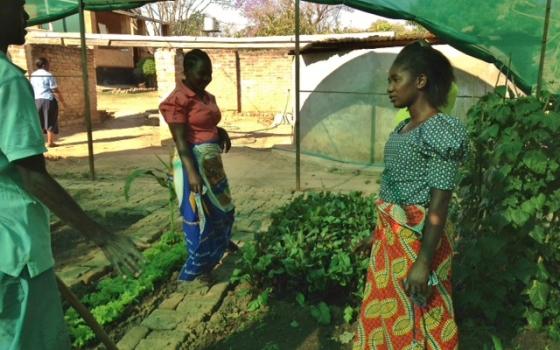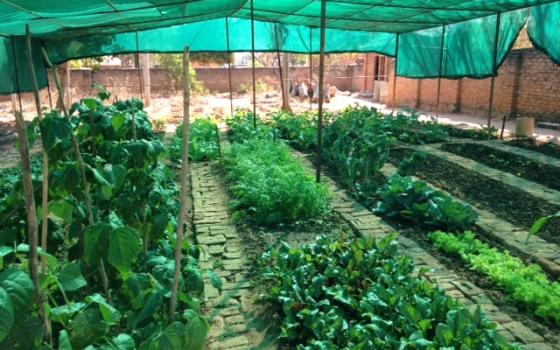We live in Mzimba, a small town in a large rural area of Malawi where our neighbors struggle every day with poverty and lack of food due to poor soil and a long and dry, hot season. Last year, our small community of sisters wondered what we could do to help ourselves and our neighbors accomplish zero hunger, one of the United Nations sustainable development goals. Challenged to consider what actions here could help end hunger and poverty, protect the planet and ensure prosperity for all, we looked to our community garden and thought about shade.
We had recently heard about a new material that was being used to make garden shades in other places of Malawi, one of the poorest countries in the world. It was successful in helping to cut down the impact of our scorching sun on vegetable gardens. After some investigation, we decided to build our own vegetable greenhouse.
Our greenhouse is very different from the traditional type used in cold countries where heat is needed to grow vegetables and flowers during winter. Here in Malawi we need to protect vegetables from the sun, especially during the hot and dry season from May to December. Growing vegetables where the average annual temperature is 92 degrees Fahrenheit, with only five months of rain, is a challenge. Often, families are hungry for about half the year.
We were very excited about our plan to build a greenhouse where we could grow vegetables the whole year-round without having to spend an extraordinary amount of money on water during the dry season. The structure is very simple, constructed with metal bars to support the sunshade material that cuts the sun's rays up to 80 percent. We planted the usual tomatoes, beans, carrots and onions and also decided to experiment with some new types of vegetables. We sowed new varieties of green leaves because they are the main part of the everyday diet for the people.
Our first year became an immense learning experience. We did not know how much shade and how much sun is needed to grow vegetables when it is raining or when it is not. We gradually learned to adjust the shades and after the first year grew enough vegetables for our own use and some to sell to our neighbors.
At this time of the year in our hot season, vegetables are especially scarce, so we were delighted the other day when a young mother with her baby perched on her back, the traditional way mothers carry their babies, came to buy some vegetables. She said she needed them to feed her other children when they returned from school in the afternoon. Being able to buy fresh vegetables made her so happy that we were sure she would spread the word to her friends.
Sure enough, her friends and neighbors came, not only to buy but also to learn from us how they might build their own greenhouses. Local women's groups also began showing up and we invited others to come and see that it is possible to grow food even in the hot season. When they come, we also suggest they consider growing different kinds of vegetables, as well as the traditional ones, to add variety to their diets.
We currently sell mostly green leaf vegetables that the women chop into small pieces and cook into a stew with tomatoes and onions to eat with traditional "nsima," a white corn meal cooked into a kind of polenta. As our experiment becomes more successful we plan to extend the greenhouse so we can increase the number and varieties of vegetables we now grow. Another goal would be that we can sell them at better prices. But our most important hope is that families will consider building their own greenhouses so they can have their favorite, healthy vegetables all year, close at hand.
Having families take up this new way of growing food will contribute to the United Nations global goals of zero hunger, ending poverty and promoting good health and well-being.
[Huguette Ostiguy is a Missionary Sister of the Immaculate Conception from Quebec, Canada, and a psychologist who lives in Malawi.]



